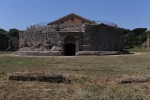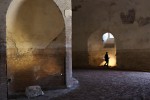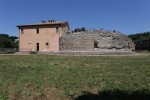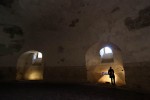 The Mausoleum of Valerius Romulus, son of the Roman Emperor Maxentius, reopened to the public Monday after 20 years of restoration. The large circular structure was built by Maxentius in the early 4th century, probably as a family tomb, on the Appian Way. When his young son died around 309 A.D. — he is said to have drowned in the Tiber — he was buried in the mausoleum.
The Mausoleum of Valerius Romulus, son of the Roman Emperor Maxentius, reopened to the public Monday after 20 years of restoration. The large circular structure was built by Maxentius in the early 4th century, probably as a family tomb, on the Appian Way. When his young son died around 309 A.D. — he is said to have drowned in the Tiber — he was buried in the mausoleum.
 The tomb was part of a large imperial complex that included Maxentius’ palace and a circus for chariot racing. Little of the palace is still standing, while the mausoleum has lost its second level but is still an impressive structure, inside and out. It is surrounded by a quadroporticus on the outside with its main entrance on the Via Appia and two smaller entrances facing the palace and the circus. On the mausoleum itself, the main entrance facing the Appia was walled up centuries ago. It has now been reopened in the recent restoration. Inside, the crypt has a large central pillar with a circular corridor onto which open niches where the sarcophagi of the royal family would have been deposited. A spacious vestibule connected to the corridor probably once led to the second floor.
The tomb was part of a large imperial complex that included Maxentius’ palace and a circus for chariot racing. Little of the palace is still standing, while the mausoleum has lost its second level but is still an impressive structure, inside and out. It is surrounded by a quadroporticus on the outside with its main entrance on the Via Appia and two smaller entrances facing the palace and the circus. On the mausoleum itself, the main entrance facing the Appia was walled up centuries ago. It has now been reopened in the recent restoration. Inside, the crypt has a large central pillar with a circular corridor onto which open niches where the sarcophagi of the royal family would have been deposited. A spacious vestibule connected to the corridor probably once led to the second floor.
 There’s an 18th century brick home attached to the back of the mausoleum that was originally a farmhouse for use when the property was dedicated to agricultural purposes. It was later converted into a home for personal use by the princely Torlonia family, who owned the land before it was requisitioned by the Fascist government in 1943.
There’s an 18th century brick home attached to the back of the mausoleum that was originally a farmhouse for use when the property was dedicated to agricultural purposes. It was later converted into a home for personal use by the princely Torlonia family, who owned the land before it was requisitioned by the Fascist government in 1943.
 The circus, while in ruins, is the best preserved of its kind, with pieces of all its major architectural components extant. Two of its gate towers have survived, as have the remains of the starting gates, the spina (the central median around which the chariots turned), and a triumphal arch. It’s also the second largest circus after the Circus Maximus at 500 meters (1640 feet) long and 90 meters (295 feet) wide. There was room in the stands for as many as 10,000 spectators to watch the races.
The circus, while in ruins, is the best preserved of its kind, with pieces of all its major architectural components extant. Two of its gate towers have survived, as have the remains of the starting gates, the spina (the central median around which the chariots turned), and a triumphal arch. It’s also the second largest circus after the Circus Maximus at 500 meters (1640 feet) long and 90 meters (295 feet) wide. There was room in the stands for as many as 10,000 spectators to watch the races.
 Parts of the circus were excavated by archaeologist Antonio Nibby in 1825, who unearthed a marble inscription dedicating the inaugural games to the deified Valerius Romulus, clarissimus puer (most highly regarded boy), nobilissimus vir (most noble man), twice consul of Rome, son of Maxentius the undefeated Augustus, grandson of the divine Maximian. Before that discovery, the circus was thought to have been Caracalla’s doing.
Parts of the circus were excavated by archaeologist Antonio Nibby in 1825, who unearthed a marble inscription dedicating the inaugural games to the deified Valerius Romulus, clarissimus puer (most highly regarded boy), nobilissimus vir (most noble man), twice consul of Rome, son of Maxentius the undefeated Augustus, grandson of the divine Maximian. Before that discovery, the circus was thought to have been Caracalla’s doing.
 Maxentius would have been very put out to find his construction project attributed to another emperor. The Appia complex was part of a major effort on his part to legitimize his usurpation of the throne through the revival of great building in the city of Rome. In the years before the Praetorian Guard made Maxentius, formerly a Caesar or junior emperor, Augustus, emperors like Diocletian, Maximian and Galerius had focused imperial construction on other cities: Nicomedia for Diocletian, Milan for Maximian, Salonica for Galerius. They brought the imperial court and administration to these cities, diminishing Rome’s political and architectural importance.
Maxentius would have been very put out to find his construction project attributed to another emperor. The Appia complex was part of a major effort on his part to legitimize his usurpation of the throne through the revival of great building in the city of Rome. In the years before the Praetorian Guard made Maxentius, formerly a Caesar or junior emperor, Augustus, emperors like Diocletian, Maximian and Galerius had focused imperial construction on other cities: Nicomedia for Diocletian, Milan for Maximian, Salonica for Galerius. They brought the imperial court and administration to these cities, diminishing Rome’s political and architectural importance.
With that in mind, Maxentius moved to build anew in Rome. The Appian Way complex was intended to be a new administrative center, not just a compound for private fun. The choice to place it on the Appia, outside of the formal boundary of the city of Rome where the tombs of the wealthy had for centuries dotted the roadside, was a break with tradition. He may have decided to build out there because he wanted his dynastic tomb to be part of the complex, and according to Roman custom, all bodies had to be buried outside the city.
You can take a look around the complex via satellite on Google Maps. To the right of the red marker are the circus ruins. Slightly up and to the left is the mausoleum.